Please visit: www.carinadowning.com
12.05.2010
8.26.2010
Love Songs for Short Story Protagonists
Written from the perspectives of characters from short stories.
Emily - William Faulkner - "A Rose for Emily"
Anna Sergeyvna - Anton Chekov - "Lady with the Dog"
Jane - Charlotte Perkins Gillman - "The Yellow Wallpaper"
Tantalia - Macedonio Fernández - "Tantalia"
Emily - William Faulkner - "A Rose for Emily"
Anna Sergeyvna - Anton Chekov - "Lady with the Dog"
Jane - Charlotte Perkins Gillman - "The Yellow Wallpaper"
Tantalia - Macedonio Fernández - "Tantalia"
4.23.2010
The River Home: Southern California Part I
The River Home: Part 1 Southern California by carinagdowning
This sound based project is another phase of The River Home and consists of ninety-six one-minute songs, one song for every year since the California Aqueduct was built.
Part I : Southern California
Part II: Central California
Part III: Northern California
(all in progress)
This sound based project is another phase of The River Home and consists of ninety-six one-minute songs, one song for every year since the California Aqueduct was built.
Part I : Southern California
Part II: Central California
Part III: Northern California
(all in progress)
3.22.2010
The River Home
BFA Degree Show

After growing up along one of California’s last free flowing rivers, I moved to a place whose landscape did not resemble home at all. Later, in an attempt to better understand how I’m affected by my surroundings, I began talking to family, friends and strangers about their experiences with the landscapes and rivers of their homes. Some confessed a deep connection, while others denied any connection at all. After hearing many stories, I had gained a new awareness of my own ties and learned that both places were home. I looked at people through rivers and at rivers through people. I took the river to get home and began to realize that home is a flexible idea. It exists not only in the places I actually live but also in places that I connect with as if I’ve lived there. I found my displaced home tucked beneath rocks along streams and in nooks across so many cities.
When I was a child, my family and I were driving home from visiting my uncle in Lone Pine. As we drove through the Owens Valley my mom pointed out the window and told me that there used to be a lake out by the mountains but that Los Angeles needed the water and so they took it. As we drove, I stared out at the empty bed for what seemed like forever, trying in vain to imagine a lake that would fill a bed so gigantic. The large-scale pushing and pulling of land and water has now become commonplace and few stop to think much about it. Only through this redistribution was it possible for the City of Los Angeles to spring from its desert land and develop into a world city. While we gained this amazing metropolis we simultaneously lost rivers, which left their beds never to come home again. This is how it goes, on and on, each flourishing at the other’s cost.










BFA Degree Show

After growing up along one of California’s last free flowing rivers, I moved to a place whose landscape did not resemble home at all. Later, in an attempt to better understand how I’m affected by my surroundings, I began talking to family, friends and strangers about their experiences with the landscapes and rivers of their homes. Some confessed a deep connection, while others denied any connection at all. After hearing many stories, I had gained a new awareness of my own ties and learned that both places were home. I looked at people through rivers and at rivers through people. I took the river to get home and began to realize that home is a flexible idea. It exists not only in the places I actually live but also in places that I connect with as if I’ve lived there. I found my displaced home tucked beneath rocks along streams and in nooks across so many cities.
When I was a child, my family and I were driving home from visiting my uncle in Lone Pine. As we drove through the Owens Valley my mom pointed out the window and told me that there used to be a lake out by the mountains but that Los Angeles needed the water and so they took it. As we drove, I stared out at the empty bed for what seemed like forever, trying in vain to imagine a lake that would fill a bed so gigantic. The large-scale pushing and pulling of land and water has now become commonplace and few stop to think much about it. Only through this redistribution was it possible for the City of Los Angeles to spring from its desert land and develop into a world city. While we gained this amazing metropolis we simultaneously lost rivers, which left their beds never to come home again. This is how it goes, on and on, each flourishing at the other’s cost.










5.25.2009
Houses and Homes II
Houses and Homes II from Carina Downing on Vimeo.
I grew up in Fillmore, a community surrounded by mountains, orchards, crops, and lots of open space and wilderness. The city is quiet and slow paced, with clean air and clear skies.
Since I moved to Long Beach in 2007 I’ve been trying to figure out why, despite my liking Long Beach for many reasons, I still feel like I could not make Long Beach my home. When I think of the differences between the places, the foremost thing that comes to mind is the Sespe River, the last un-dammed river in Southern California, which provides water for plants and animals in the Los Padres Forest and for the orchards of the Santa Clara Valley. Slow moving and natural, the Sespe River and Wilderness is the backdrop and symbol for what it is like to live in Fillmore.
I’ve searched for an equivalent in Long Beach and found the Los Angeles River, however its waters are severely polluted with flow from storm drains and constrained into a cement channel; plants, animals, soil and rocks are nearly non-existent. Historically however, the City of Los Angeles was built at the banks of this river and its waters sustained the community, as well as many species of plants and animals. Channelizing the river helped the city grow to the metropolis it is today, making new homes possible for some, while taking away the habitat of others.
I have worked on Houses and Homes II to explore this importance of rivers to these communities. I interviewed individuals from Long Beach and Fillmore to learn about their feelings and experience with the Sespe and Los Angeles River. I’ve been able to form intercommunity relations and explore the benefits of collaboration and connection with people who are not typically involved in the field of art.
Houses and Homes II was displayed in February of 2009, at the Maxine Merlino Student Gallery at CSULB. In the initial installation, the videos of the Los Angeles River and the Sespe River were projected onto opposite walls of the gallery and the sound of people talking about their experience of the Sespe or Los Angeles River played out loud in the space.
10.29.2008
Houses and Homes I

This month I had a solo student show open at California State University Long Beach, Maxine Merlino Gallery. I am currently in the Photography BFA program here.
The Difference Between Houses and Homes is an installation study of how we relate to the homes we grew up in and how we adjust to the houses we move into after we leave our childhood home.
The installation featured interviews with people about their experience moving away from home for the first time, a recording station for those who wish to share their own experience, as well as photography comparing the views outside the windows of my childhood home in Fillmore, CA to the first house I lived in when I moved to Long Beach, CA.
The sound recordings from the exhibition are at the bottom of this post.
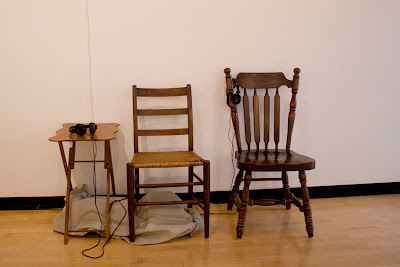
Listening station
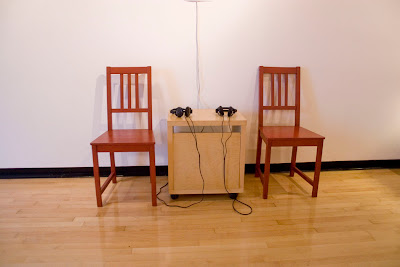
Listening station

Listening station

My mom and me at the opening.

The recording station where visitors could make recordings about their own experience of moving away from home.
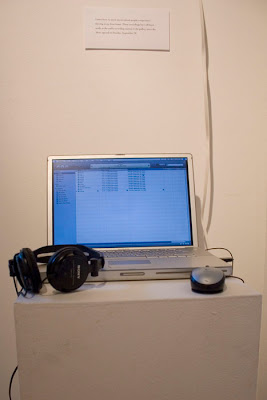
I collected the recordings that people made at the recording station and put them onto my laptop. All together fifteen people participated over the five day period that the show was open during.

Photographs on the right were taken out of every window from the home I grew up in, in Fillmore, CA. Photographs on the left were taken out of every window from my house in Long Beach, CA.
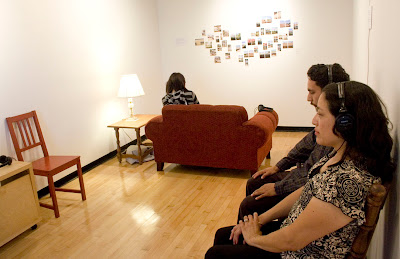
Mom, Jose and Pan.
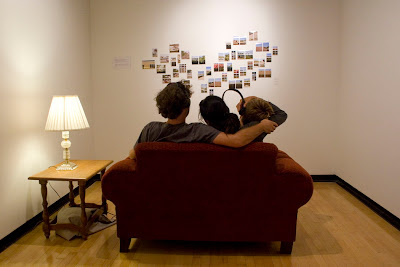
Jeremy, Amelia and Diego.
Below is the audio from interviews I did with people about their experience moving away from their parent's home for the first time.
Dad
Gina
Grandma and Grandpa
Jim
Julie
Mom
Morgan
Pam
Rosangela
Seema
Here are recordings that gallery visitors made themselves about their own experience.
Anon 1
Anon 2
Tracy
Cupcake
Darlene
Hannah
Javier
Jennifer
Jessica
Julie Good
12.24.2007
Wonder Tunnel Interview

Jeremy Kirsch: What is The Wonder Tunnel? Tell us a little about the project and how it came about.
Carina Downing: I’ve been thinking about the Wonder Tunnel for a couple of years now. It actually started off as a seedling idea. I was doing weird things like leaving these envelopes in places for people to find and in the envelopes there would be photographs. I left these things in bathrooms and schools, on tables at cafes and taped them to business windows. This was all because of this wonder idea where I figured that if I were to find one of these envelopes I’d be really jazzed and excited wondering where it came from and what it was all about. So I figured other people would appreciate that too.
Later I thought about making this little box-like tunnel thing that would have hinges and would fold up and I could transport it around towns and drop it in public parks and then watch and see if people would go in it and maybe film it too. Oh, and inside there would be things on the walls to look at and things on the ceiling too, although I didn’t work through what these things would be. But I wasn’t really sure if it was a good idea and when I remembered that this would involve me having a truck to lug it around and I didn’t have a truck so I forgot about the tunnel for a while.
Then when a few months later when I went to school up in San Francisco I had an assignment to make a proposal for a public art project and this other student, Artie, and I we made a crazy proposal to get tons and tons of cardboard and essentially stitch it together and create a 12 foot wall out of it that would block a huge section of the entrance to the SF State campus and force people to either walk around it or to go through it. Of course, when you went through it you found yourself in a series of cardboard rooms which eventually led you to a “Curiosity Cocoon”. This “Curiosity Cocoon” is pretty much the Wonder Tunnel except it would have been designed as a tapering tunnel which you would eventually have to crawl out of. However we never created the cardboard fortress.
Finally, a couple of months ago when you asked me if I could make something for GO GALLERY I immediately thought of the tunnel. I forgot about the clever name “Curiosity Cocoon” and since the first thing I blurted out was Wonder Tunnel that was the name that stayed. So I decided to make it. With the help of my parents Jim and Vanessa and my sister Larissa we worked through the idea and decided to expand the tunnel to be big enough to walk through amongst many other decisions. They helped keep the idea in check in a big way.
I wanted people to be able to explore each others wonders and I’ve found many though provoking, funny, and interesting wonders in the tunnel already. The tunnel is really about people connecting with other people and being able to be comfortable with art and develop a personal connection with it. I’m not so interested in having to stay an arms length from art at all times. Some times it seems like this is art, and that is you, and stay away and don’t touch it, or mess it up. But art is really just another part of life and people should be able to form connections with it.
JK: Your work is primarily interactive and involves communication between the artist, the viewer and amongst the viewers as a group. What kind of dialog does your work create?
CD: I’ve had some great conversations with people over the Wonder Tunnel. I feel like it is really reaching out to people who aren’t necessarily gallery-goers or art students, or involved in the art community and this is really important to me because I want to make art for all people not just art for other artists to see.
I’ve had people come up to me asking where the idea came from and did I really make it up. I guess its not the most common thing, to be making art that visitors touch and add to these days and so lots of people were really excited about it. They were asking me if they could add more and what was the limit.
It was great to talk to them after they got out of the tunnel because I would ask them if they found any good ones and each person had a totally different response. One person would say, “I liked the one that said, “I wonder why Zack was friends with Screech on Saved by the Bell”. Another person would say, “I like the one that said,” I wonder what its like to be blind”. And another person would say, “The best one was the one that said, ” I wonder what its like to dance at your own wedding”
Each of these wonders was so different and so were the people that were contributing to the tunnel. It was like a buffet, everyone could find something they liked.
I got a lot of people who admitted that for the most part they didn’t really “get” art but that they actually liked the tunnel, which was really great that they could relate to it. People were saying that they really enjoyed the interactivity.
JK: You are active not only as a conceptual artist, but as a visual artist, musician and video producer. Talk to us a little about these projects. As an artist, what role can an artist have in bettering the local community?
CD: Mmm… I really can’t make up my mind that’s all…
Well as far as visual arts go I’m a photography major at Cal State Long Beach right now so I do photography a lot, hence the photography on the walls in the gallery right now. I really like photography but I find it difficult to really create a dialog with just photographs so that’s what makes me do conceptual art and then document that art with photos.
It seems like most people just see the picture, keep on walking, see the next picture, keep on walking, and say “well that’s interesting” and then leave the gallery. I’m not so interested in the conversation ending with, “well that’s interesting” so I try to make things hands-on engaging whenever possible.
As far as music goes, I love playing it. I’ve been doing something music related for since I was a child but have only been writing my own songs for about five years. My song writing process is extremely slow though, so even after five years I only have about five songs that I’ve kept and perform live nowadays. Besides my solo stuff I’ve written a few songs with Pam Gartner and Jose Serna but those are recorded and we’ve made them complicated enough where were still trying to figure out how to perform them live. So that’s in the works still.
And now for the videos. I have a few that are documentation of public art projects. There are a couple videos I’ve participated in with collaboration. We did these Lunchtime Limbo interventions where we went into San Francisco with a ton of Hawaiian leis, a boombox blasting limbo songs, and a limbo stick and tried to get people downtown to do the limbo at noon. It worked out so well in San Francisco that we did it in Ventura the next year however the response was much less enthusiastic. I also made a short movie called Charlatan in 2005 that was about the way that people sometimes treat television like a replacement for people. It showed a few satirical scenes in which television just wasn’t measuring up to being like a human.
Besides those videos I also co-founded a music and arts production group called Songs from a Window with Jose Serna. We do a online/public access TV show where we feature local musicians and do performance footage and an interview segment as well. These have been really fun and a super learning experience.
How can artists better the community eh?
Well first off I want to clear it up that I have a weird idea about artists. Really I feel like I just happen to really want to make visual things, and interactive things, and music things and that I feel pretty comfortable doing this so you might say that its a talent. But the thing is that really everyone has a talent and its not necessarily making something visual or music but it may be that they are really patient, or that they can fix faucets super well, or that they can make quilts.
So really I think that being an artist is just taking what you can do and doing it and then offering it up for other people. So musicians can make their music and people will enjoy it, and faucet fixers will help fix faucets and people will benefit, and patient people will keep their patience and that will be their contribution but as long as you acknowledge that you can do something well and then you do it, you will be helping with whatever that thing you do well is. I don’t want to sound like I’m just saying “oh I’m so talented”. Thats not what its about, but I think that if people did use their talents more often and offer their talents up to others that that is the best contribution to the community.
So I want to thank the people who did that just within this wonder tunnel show, you Jeremy got the hype up with your graphic design skills by making the postcard announcement look so professional, the musicians all came a played for free because they enjoy it and want others to enjoy it to, my family all used their separate talents to help me create the wonder tunnel. My dad helped with the construction, my mom the decoration, my sister, and Jose helped put up the hundreds of envelopes. And my mom used her awesome food skills to provide some delicious foods.
And it all came together to create one great night, where a bunch of nice people who didn’t all know each other all got together to talk and see and listen and that community vibe was going strong.
JK: What do you want to be when you grow up?
CD: When am I considered grown up? Um, it feels strange to plan things that are so far away in both time and in how much I have to learn before I can do this but I’d like to continue making things like art and music and then also sometime after I get my BFA and MFA I’m going to become a photography professor at a community college.
http://cphotography.blogspot.com
http://myspace.com/songsfromawindow
5.28.2007
4.11.2007
11.16.2006
Lunchtime Limbo San Francisco, CA
November 2006. Artie, Erica, Brianne, Christina, Samantha and me, take a limbo stick, boom box and Hawaiian leis to downtown San Francisco and limbo with every willing passerby.
9.07.2006
Letters to Strangers
Letters to strangers is an exploratory project. I'm interested in the role that wonder plays in everyday life and in this project have chosen to leave my art in public places hoping to incite wonder in the people who find it.
The images below were put into envelopes and left in parks, restaurants, libraries, buses, trains, coffee shops, art galleries and taped up on various walls.
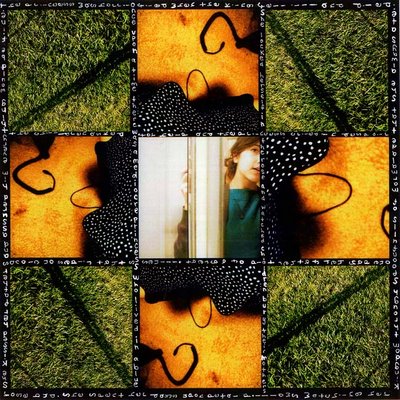
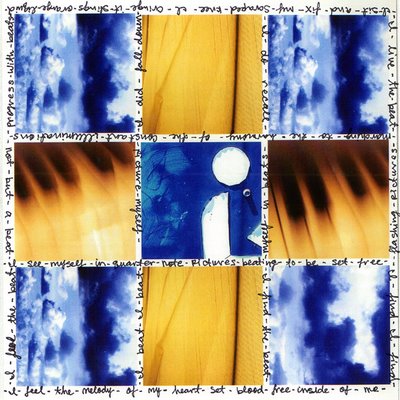
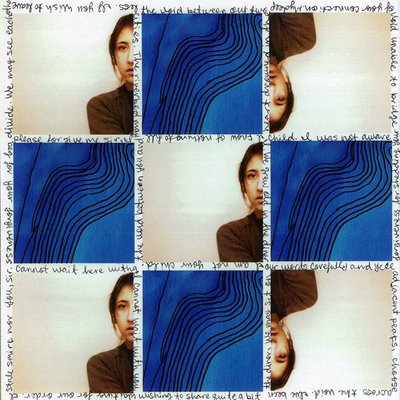
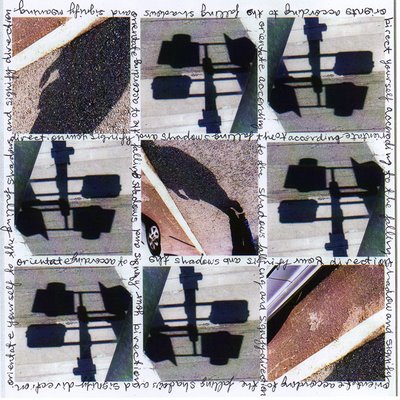
The above images are from a collaboration with Joseph Castaneda. I took the photographs and arranged the compositions and he wrote the poetry that rests between the images.
As I left these envelopes I documented the process in the same collage style.
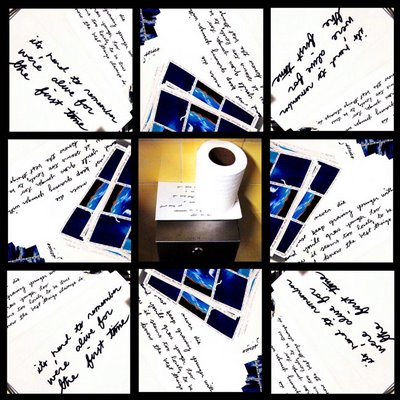
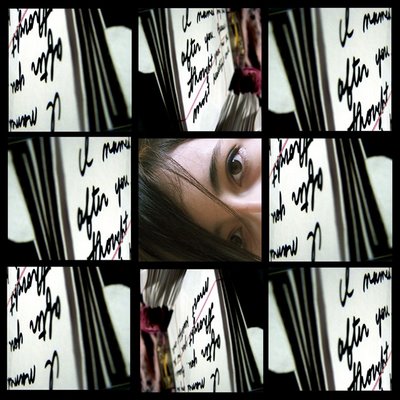
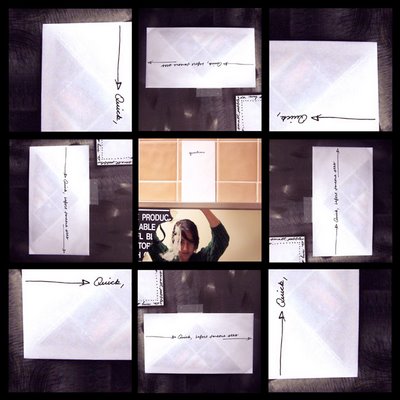
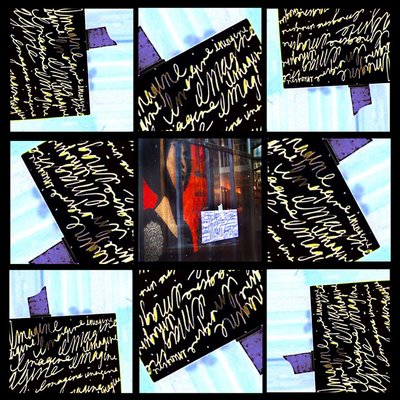
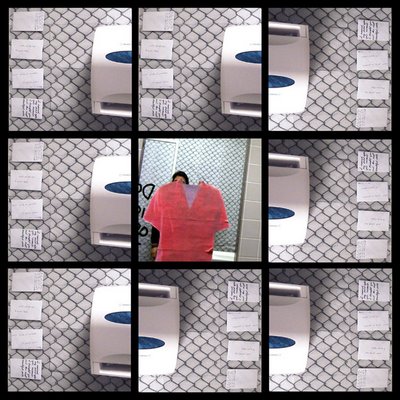
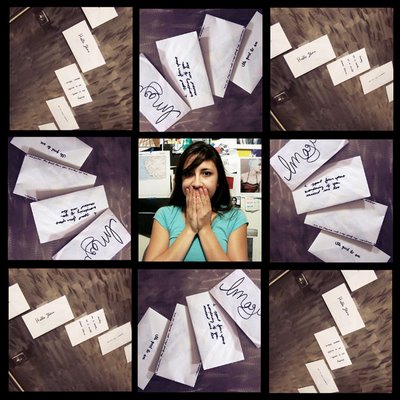
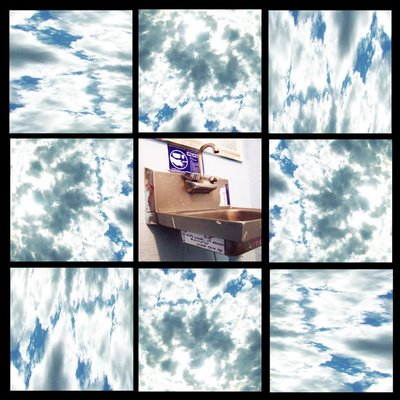
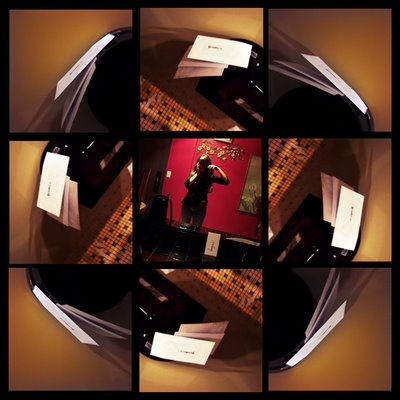
afterwards, i got the documentation as well as the originals and used all the images in a temporary installation which was also documented.
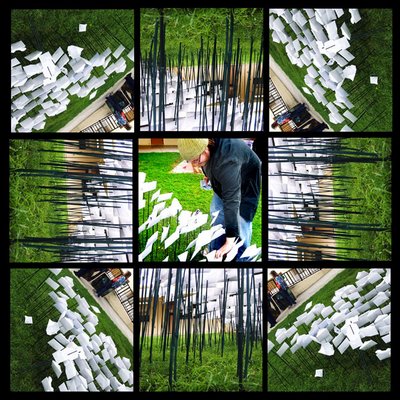
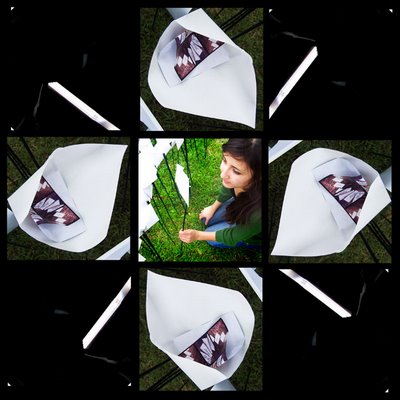
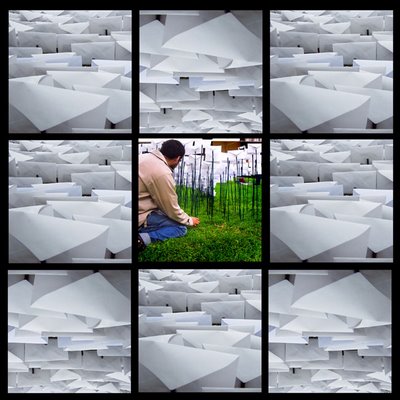
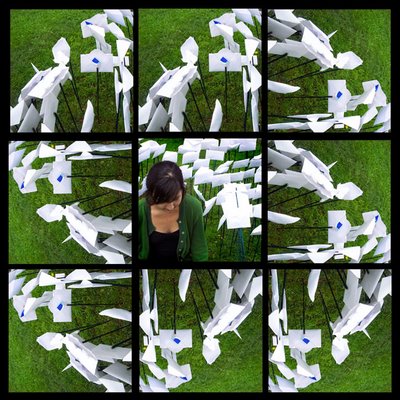
now i'm continuing the project by using boxes instead of envelopes. some boxes have pieces of super 8 film in them that i got from the cutting bin of the cinema students at sfsu.

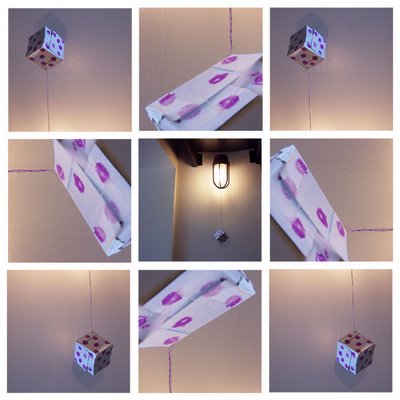
The images below were put into envelopes and left in parks, restaurants, libraries, buses, trains, coffee shops, art galleries and taped up on various walls.




The above images are from a collaboration with Joseph Castaneda. I took the photographs and arranged the compositions and he wrote the poetry that rests between the images.
As I left these envelopes I documented the process in the same collage style.








afterwards, i got the documentation as well as the originals and used all the images in a temporary installation which was also documented.




now i'm continuing the project by using boxes instead of envelopes. some boxes have pieces of super 8 film in them that i got from the cutting bin of the cinema students at sfsu.










